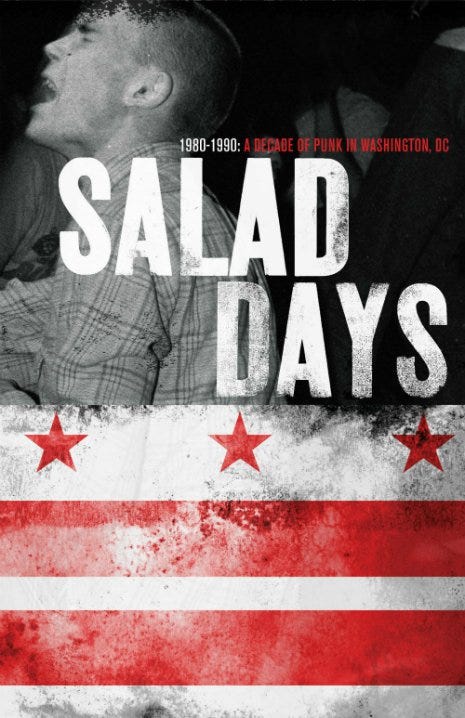So What, Who Cares (vol 2, issue 5) Who wants a follow-up round-up?
Hello! As you all know, news keeps happening and things evolve over time. One of the questions that's popped up since I began So What, Who Cares is this: If I see something that would have been awesome for a previous issue of So What, Who Cares, what do I do with it?
The answer: I'll be doing periodic round-ups of links that tie right back into previously covered topics. Let me know if this format works for you, okay? (Tell me via email or Twitter.) Your feedback is what makes this newsletter useful to you.
*
Punk culture: not just for scary-looking young people in the big city (vol 1, issue 29; vol 1, issue 39; vol 1, issue 40), as evidenced by a piece about The Country Grind Quarterly, a zine by and for rural punks. Publisher Gretchen Bonegardener explains the appeal of the rural punk life thusly:
I like the lack of people telling me what I can and cannot do. I can go sit on my front porch and shoot off my gun, and blast music as loud as I can and nobody cares. I mean I don’t do that all the time, but I can, and that’s nice.

There's also a Q&A with the creators of a new documentary on the D.C. punk scene of the 1980s, Salad Days. Director Scott Crawford and editor Jim Saah are basically quote machines explaining the diffusion of punk ethos into mainstream culture over the last 30 years. Saah has the killer quote:
The punk ethos taught me to believe in myself, and also taught me how to not settle for what’s put in front of me in regards to art and culture.
You can also check out the interview in The Atlantic, where Crawford explains how the late Marion Barry was an inadvertent patron of the punk scene. DC-area readers will be especially interested in the piece.
And I direct you all, of course, to the 2013 essay in Seattle Weekly, "Punk Rock Is Bulls***," which calls BS on the whole punk-DIY ethos and argues that the end of the Cold War rendered punk irrelevant. I'm including it because I think it provides a nice framework for arguing against the previous punk coverage on SW,WC.
*
Businessweek would like you to know that the subscription box mania is officially "out of control," saying the boxes are wasteful and don't provide a good value for the money.
There are, alas, no hard numbers on how subscription boxes are wasteful or how to calculate 'value for the money.' Nor is there any explanation for the motivation of consumers or the introduction of brand integration into the market (vol 1, issue 34). For a more incisive analysis on subscription boxes -- including a very good explanation for why it probably makes more sense to ignore "subscription box" as an industry vertical and focus instead on the product category (i.e. makeup, pet toys, snack food) that the box delivers -- read Pacific Standard's great piece from May 2014.
I did learn, however, that there exists a lady who blogs about the seventy-five boxes she subscribes to monthly.
*

The Atlantic continues the important work of covering the politics of human elimination in India (vol 1, issue 8; vol 1, issue 40). Prime minister Narendra Modi has made it a goal of his administration to eliminate open-air defection by 2019, and one of the ways he intends to do that is by deploying sanitary inspectors to go door-to-door and verify the actual use of toilets; they'll use mobile technology to upload the results of their inspections in real time. Jack Sim, president of the World Toilet Organization, had the piece's money quote: "Ultimately, toilets have to become a status symbol and a lifestyle choice in order to become a norm."
*

Your pop culture follow-up note of the day: I will admit, I have been giving the side-eye to "marsala" ever since it was crowned the "It" color of 2015 (vol 1, issue 64), and I have been curious to see if/how it filtered out to the usual vectors of mass-market style.
One of those vectors is celebrity-driven fashion -- and you all should read Teri Agins' Hijacking the Runway for its incisive, dishy explanation of how we came to be wearing Kardashian-branded klothes -- and I want to point you to two excellent articles that pre-dated the Golden Globes carpet: Fashionista.com's "How 'It' items go in and out of fashion," and the Hollywood Reporter's "Golden Globes fashion: What will be this year's 'It' color?"
The former article explains how things bubble into the collective cultural conscience:
“It has to have a reason to be,” says Roopal Patel, founder of Roopal Patel Consulting. “I think that’s what really constitutes an It item these days: What is it adding to the cultural space?”
and the latter forecast the likely red carpet trends:
[W]hile Pantone showed us rich wine, many 2015 spring and prefall fashion shows gave us prints, blues and greens, black with white and two-tone looks (such as Lizzy Caplan's standout Emmy Donna Karan gown, with its black front and white back). Says stylist Nicolas Bru: "The spring 2015 runway presentations had a lot of blues and greens and all shades in between: turquoise, Lucite green, mint, pistachio. I think we will see a lot of those colors this awards season on the carpet."
Also expect black-white, wine and perhaps some shades of pink for the Globes (the Feb. 22 Oscars will reflect January couture shows in Paris and the fall 2015 shows in New York and Milan). And don't rule out prints and embellished fabrics with multihues — after all, the most novel look always gets the most ink.

So how'd the Hollywood Reporter's predictions pan out? I noticed that eight of Fashionista.com's ten so-called "best" looks from the Golden Globes hit black, white, or embellished-fabric notes. Jessica Morgan and Hather Cocks singled out 18 best and worst picks for New York magazine, and fourteen of their selections hit the trends. And the Hollywood Reporter ate its own dog food with eight out of ten best-dressed pics referencing their trends piece.
I sincerely hope to see a follow-up piece next year forecasting the trends for 2016. I'd love to see what colors are hot and what they're adding to the cultural space.
*
Did you miss an issue of So What, Who Cares? The archive is here. Are there typos? I apologize in advance.
As always, I welcome your feedback and suggestions via email or Twitter. Always let me know what you think about So What, Who Cares? If you really like it, tell a friend to subscribe.

